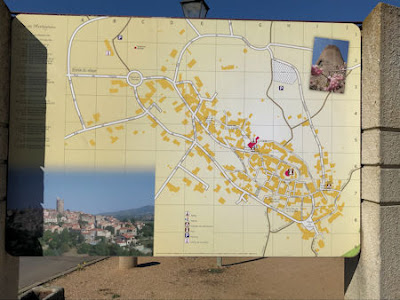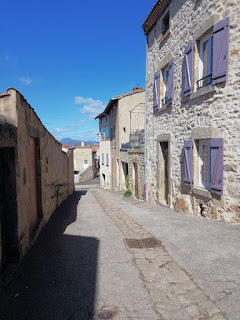On a somewhat chilly day in late March, we wanted to stroll through another of the villages that aren't too far away. Today's choice - Montpeyroux. As with the village of Usson, visitor owned cars are not permitted in the village so you park on the outskirts.
The alleys and archways of Montpeyroux date from the 12th century. Apparently there is no mention in historical documents from the 11th century, but it was mentioned by 1212. It was named one of France's "beautiful villages" in 1989.
The name Montpeyroux comes from "mons petrosus" which means stony mountain. The area was once famous for its noble arkose stone quarries. Arkose stone is a kind of sandstone and is ochre/sandy in color. They say it gives the houses and streets of Montpeyroux a warm tone. The arkose stone was used to build the area Romanesque churches including the Notre Dame du Port in Clermont-Ferrand. (This is a different church than the one built of volcanic black stone that we've written about previously.) Many from the village earned their livings in the quarries. The last quarry closed in 1935. There was a display of the quarry history. The last thing the quarries produced were milling stones.
Montpeyroux has a rich wine-making history as well, especially during the 19th century. However, between 1890 and 1927, wine production suffered and then WWII occurred. All of this had an impact on the population of the village. In the 1960s the village was rejuvenated as artists and craftsmen moved in. These shops were all closed during our visit. We did see one restaurant open for take-away but they didn't start serving until later in the day. The menu sounded good, however.
Some shots as we walked in the village.
Interesting door.
The archway in the distance dates to the 14th c.
Public toilets is a nice feature, though the doorway is not very tall.
The medieval keep (33 meters tall) was built during the 2nd half of the 12th century.
It had political and military importance. The keep was a fortified tower which often served as the Lord's residence but was also the last place of refuge when defending the castle. By the way, Catherine de Medici, and later her daughter Queen Margot, were both Lords of Montpeyroux.
From the top of the tower (closed due to time of year) you have a 360 degree view of the surrounding area. In the distance you can see the Sancy Massif and the mountains of Cantal. We got a couple of nice shots from down in the village. Yep, that's snow still in the mountains. The elevation ranges from 5400-6100 ft.
The "lawn" areas were covered with this white-flowering ground cover and some tiny purple flowers.


















No comments:
Post a Comment
Feel free to comment or ask questions...